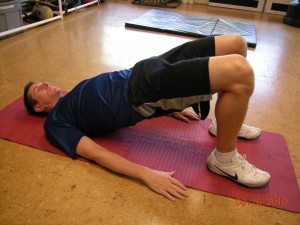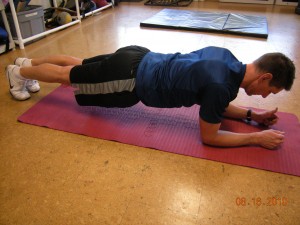
Bridge
The Bridge is a great core exercise. It helps to strengthen the hamstrings, gluteals, and all of the muscles that support the lower spine and pelvis. This picture shows the end position of the bridge. To start you want to lye flat on the ground, bend your knees to about 90 degrees. Then press through your heels and lift your hips toward the ceiling. The goal is to lift your hips high enough so that there is a straight line through your knees, hips and shoulders. Hold for 30-60 seconds and repeat 3 times.
Plank
The Plank is a core exercise that is rooted in Yoga. It helps to strengthen all the muscles that stabilize the spine and pelvis as well as the shoulder. Start by lying flat on the ground. Your elbows should be directly under your shoulder and your feet should be together with your weight on your toes. Lift your hips up so that only your toes and elbows (forearms too) are on the ground. Lift your hips until there is a straight line through your shoulders, hips, knees and ankles. The weight of your body should be directly over your elbows and toes. You should avoid pressing forward on your elbows or backward on your toes. Also avoid “A-framing” (hips too high) or “Sagging” (hips too low). Hold this position for as long as you can. Repeat 3 times.
Pointer
This is called a pointer because when you perform it you look like a pointer dog. Start on your hands and knees with your hands directly under your shoulders and your knees directly under your hips. Lift your right hand and left knee one inch of the ground. Hole this position while attempting to avoid any movement in the rest of your body. Take 4 seconds to slowly extend both your arm and leg simultaneously. Then take 4 seconds to return them to the start position (with out touching your hand and knee to the ground). Do 8-12 Repetitions on each side.
Boat Pose
The Boat Pose is also rooted in Yoga. I typically call this Coccyx Balance, because your coccyx bone is your tailbone. Balance on your tailbone lift your feet so that your shins are parallel to the ground. Your arms should be by your side, also parallel to the ground. Lift your sternum (breast bone), so that your spine is flat. Hold as long as you can. Repeat 3 times.
Add theses four core exercises to your daily routing. Do them everyday. Watch the video below to learn more about how to perform these exercises correctly. I’ll be back tomorrow with Tip #10
[youtube]http://www.youtube.com/watch?v=4Djq1SjwlW0[/youtube]






